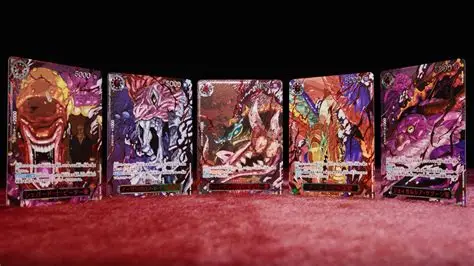Crossovers are nothing new in anime and manga. Characters have shared stages in special episodes, and game developers often pull inspiration from multiple series. Yet once in a while, a collaboration feels bigger than a novelty. That is the case with the newly announced One Piece Card Game set featuring artwork by Gege Akutami, the creator of Jujutsu Kaisen.
Akutami has lent their unmistakable style to five new cards depicting the Gorosei, the shadowy Five Elders of the World Government. Each card presents two faces: their familiar human form and a chilling, demonic transformation. The result is a collision of Eiichiro Oda’s sprawling pirate saga with Akutami’s gift for horror and the grotesque.
Fans erupted as soon as the designs were revealed, calling the project a dream crossover. But beyond the hype lies something deeper: a meditation on power, corruption, and the way card games have become vehicles for storytelling as much as strategy.
The Gorosei: Pillars of Mystery and Power
Why the Gorosei? Few figures in One Piece embody secrecy and authority as they do. Seated in the Holy Land of Mariejois, they stand as the visible rulers of the World Government.
Oda has kept their histories veiled, teasing their importance across decades of storytelling. Only in the Final Saga have their true powers begun to surface. Far from mere bureaucrats, the Gorosei reveal monstrous, almost divine forms that tie directly to the lost history of the Void Century.
Placing these figures in Akutami’s hands highlights their dual nature. As politicians they command through words and presence. As demons they embody terror itself. It is a balance of masks and revelations perfectly suited to Akutami’s vision.
Gege Akutami’s Style and Why It Fits
Jujutsu Kaisen thrives on the tension between the human and the inhuman. Akutami’s world is one of curses, trauma, and relentless mortality. The art mirrors that mood: jagged lines, stark contrasts, and faces stretched by fear or cruelty.
Applied to the Gorosei, this approach produces something uncanny. Their monstrous forms in Oda’s canon already flirt with nightmare imagery, but Akutami amplifies it. Limbs stretch unnaturally, eyes blaze with malice, shadows consume the page. The results recall Sukuna’s grin or Mahito’s twisted glee, reframing the Gorosei as beings who look less like rulers and more like curses disguised as men.
Card Design as Storytelling
The One Piece Card Game has carved out its identity by translating arcs and characters into mechanics and visuals. A card is not just a piece of play equipment. It is a fragment of narrative, a reminder of where the character fits within the larger mythos.
With Akutami’s Gorosei, the cards function almost like mirrors.
-
Human forms: dignified elders whose calm posture and cold gazes radiate authority.
-
Demonic forms: nightmare apparitions stripped of diplomacy, embodying raw violence and deception.
This pairing becomes more than flavor art. It dramatizes their duplicity and invites players to wield them as both political tacticians and destructive monsters. The cards themselves tell a story: power maintained through illusion, fear, and hidden strength.
Fan Reactions
The announcement immediately trended across both fandoms. Discussion clustered around four main points:
-
Sheer excitement: Many called it a once-in-a-lifetime crossover, proof of how far the One Piece Card Game has come.
-
Design acclaim: Akutami’s demon forms were praised as even more menacing than Oda’s original drawings.
-
Lore speculation: Some wondered whether the imagery hints at deeper truths about the Gorosei within the manga itself.
-
Card game momentum: Collectors and players alike saw it as another sign of the game’s growing cultural weight.
Across social platforms, fans posted side-by-side comparisons, made tribute art, and argued about which card struck the perfect balance between elegance and terror.
Crossovers in Shonen History
Shonen has seen its share of collaborations, though few match this in tone.
-
Dragon Ball x One Piece x Toriko delivered a lighthearted banquet and tournament.
-
Bleach x Naruto produced joint illustrations and playful promotional tie-ins.
-
Death Note x Bakuman included subtle Easter eggs linking the creators’ works.
The Gorosei collaboration stands apart because of its gravity. This is not comedy or nostalgia bait. It is a reimagining that leans into darkness, reshaping iconic figures in a way that feels like an alternate canon.
Symbolism and Thematic Depth
Part of what makes this crossover resonate is how naturally it bridges the themes of both series.
-
Corruption and authority: The Gorosei embody political rot. Jujutsu society sacrifices its youth for tradition and order. Both critique systems of power.
-
Masks and truth: The elders appear wise but hide their demonic essence. Curses in Jujutsu Kaisen often wear human forms.
-
Fate and defiance: One Piece champions inherited will and the pursuit of freedom. Jujutsu Kaisen confronts the cruelty of destiny and asks how far individuals can resist it.
Akutami’s artwork captures these parallels without words, layering metaphor into imagery.
The Future of the One Piece Card Game
The timing is no accident. Since its launch in 2022, the One Piece Card Game has surged in popularity, competing with titans like Pokémon and Yu-Gi-Oh!. High-profile collaborations like this give it cultural heft beyond the tabletop.
It is easy to imagine further experiments. Naoki Urasawa reimagining Blackbeard as a psychological villain. CLAMP drawing Boa Hancock with ethereal grace. Each would add new layers to Oda’s cast while strengthening the card game’s identity as a living, evolving art project.
Conclusion
The Gorosei crossover is more than a novelty print run. It is a rare union of artistic voices, with Oda’s mythmaking colliding against Akutami’s nightmare sensibility. By focusing on the most enigmatic rulers in One Piece, the project underscores themes of corruption, duality, and hidden power.
For players, it adds compelling new cards. For fans, it offers a visual feast that reframes beloved lore. And for the culture at large, it demonstrates how anime’s biggest franchises can collide to create something that feels at once familiar and entirely new.
The Gorosei, those shadowed architects of the One Piece world, now stand as bridges between universes. Under Akutami’s pen, they are no longer only Oda’s creation. They are symbols of what happens when fandoms converge, when art styles clash, and when darkness is given a new form to wear.

